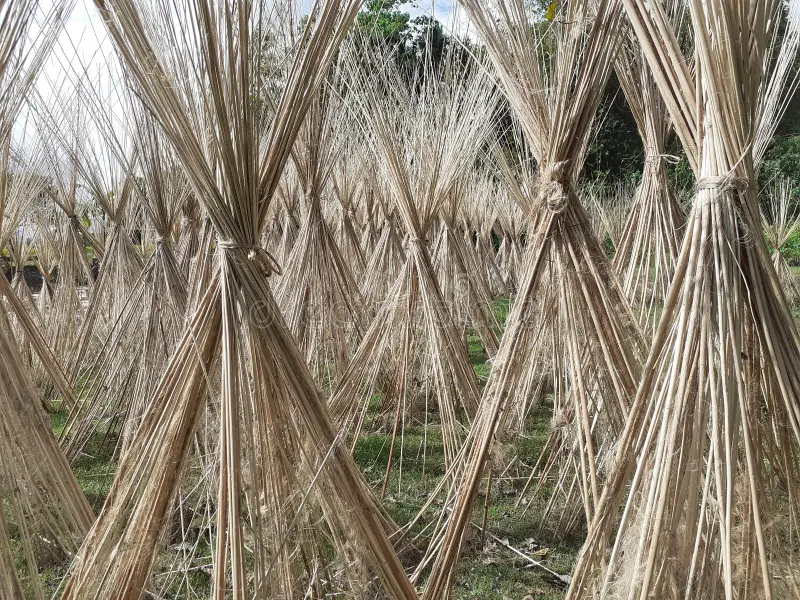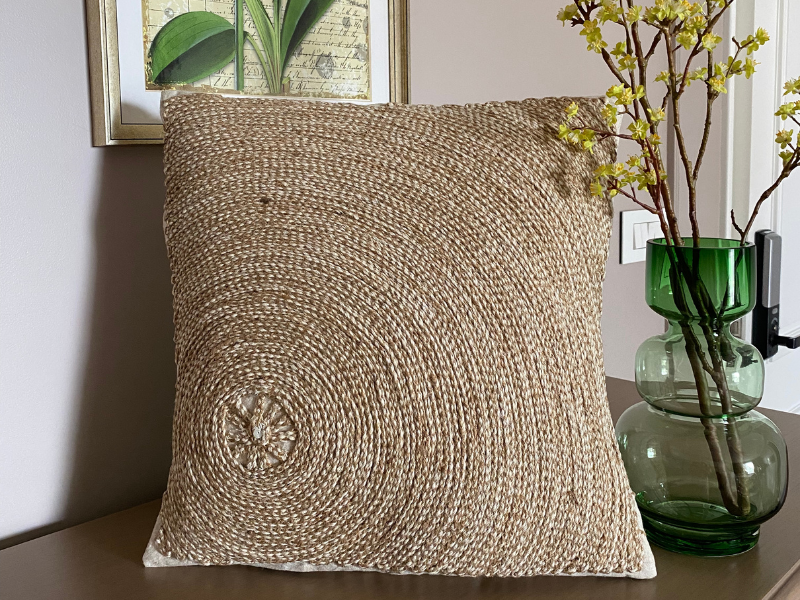Jute is a natural fiber that comes from jute plants, derived from the region of India and Bangladesh. It is opted for due to its high durability and biodegradability, and is used for the production of multiple products. Lately, the sustainability practices have made jute highly popular, and it is used to produce jute bags catering to environment-conscious consumers.
The article below comprises a detailed overview of what jute is, where it is used, and how it benefits the environment. So, let’s read.
What is Jute?

Definition:
Jute is a plant-based fiber that has long strings consisting of strong and soft threads. It comes from the jute leaves that belong to the Corchorus genus. It is highly affordable and used for industrial purposes due to its economic feasibility. It is used for producing handbags, industrial textiles, rugs, etc.
Jute is a natural fiber derived from subtropical regions where there is high rainfall and humidity. The leading jute producers are India and Bangladesh. They have an ideal climate that makes the conditions favorable for the jute plant to grow. It takes around 4 to 6 months for jute to grow and be put to use.
Characteristics:
Jute comprises various properties that make it a suitable choice in different industries, and some of its characteristics are as follows:
- Jute fiber is known for its strength and resistance to wear, which makes it suitable for load-bearing applications like burlap bags, rugs, and ropes.
- It is biodegradable and hence doesn’t impact the environment like synthetic materials, and decomposes naturally.
- Jute is breathable and has good insulation properties, making it suitable for textiles and reusable bags.
Environmental Benefits:

Jute is an eco-friendly alternative to synthetic fibers and plastics for a lot of reasons, and some of these are:
- It is usually harvested, and the cultivation process has a low impact on the environment.
- Jute products are biodegradable and do not cause any sort of pollution or waste.
- It uses minimal water and fertilizers compared to other crops.
- Jute has the tendency to absorb carbon dioxide in large amounts and release ample oxygen, making the climate comfortable.
What is Jute Fiber?
Jute Fiber Composition:
Jute fiber has a major component of cellulose and lignin; these components add durability and strength to jute and make it softer. The outer skin of the jute plant stalk, known as the base, comprises jute fibers. They are golden brown shiny and long fibers that enhance the look of everything for which they are used and are called golden fiber. It is grown in the Indian subcontinent.
Harvesting and Processing:
The process of converting raw jute into a usable form comprises various steps, and these are as follows:
- Jute is sown during the humid climate and annual monsoon season, and after 4 to 6 months, it is harvested.
- The jute plant is harvested when it is 10 to 12 feet tall and is then bundled for retting.
- The retting stage consists of soaking the bundles in water for around 15 to 20 days so that microbial activity can take place and bind the fibers perfectly.
- Once the retting process is completed, the softened stems of jute are stripped so that the silky and long fibers can be extracted.
- Raw fibers are thoroughly washed to remove any impurities and are then left under the sun to dry.
- These fibers of jute are then spun into threads and processed to manufacture products like textiles, bags, and ropes.

Advantages of Jute Fiber:
Jute fiber is equipped with many benefits, and some of these include the following:
- Jute production uses little or no chemical fertilizers or pesticides and also consumes a very limited amount of water, leaving behind a low carbon footprint.
- It grows very quickly compared to other natural fibers and can be harvested multiple times a year.
- Jute enhances the fertility of the soil and can be grown on the same land again and again.
- It is highly biodegradable and can decompose on its own, leaving behind zero waste.
- When compared to other fibers, jute needs a very minimal amount of energy for processing and harvesting, reducing environmental impact.
What is Jute Fabric?
Definition of Jute Fabric:
Jute fabric is a woven material made using processed fibers of jute. After the raw fiber is cleaned, it is spun into yarn and is woven, turning out to be a versatile fabric that is highly breathable and has a rugged texture. It is also called hessian cloth.
Jute fabric has good insulation properties compared to synthetic fabrics, followed by a rough texture and light brown color, which gives a rustic look. Hence, it is widely chosen for decorative as well as functional applications. It is very commonly opted for in the home decor and fashion industry.
Uses of Jute Fabric
Fashion and Apparel:
The fashion industry is highly dependent on jute as it works like a sustainable alternative to synthetic materials. Many brands and designers opt for jute due to its low impact on the environment and seamless appeal. Different fashion products made using jute are tote bags, shopping bags, shoes soles, clothing accessories etc.
Home Decor:
Home decor products also tend to use jute fabric, enhancing the interiors in an environmentally friendly way. Some of the home decor usually made using jute consists of rugs, curtains, blinds and chair covers etc.

Industrial Uses:
Jute is highly affordable, and due to its durability, it is used for various industrial applications. Agricultural products packaging material for grains and vegetables is made using jute. It is also opted to protect construction material and control soil erosion.
Jute vs. Other Natural Fabrics:
When compared to linen and cotton, jute is eco-friendly and also doesn’t need as much pesticide and water for cultivation. It has quick growth and is affordable to produce, making it suitable for manufacturing sustainable products.
Although cotton and linen are soft and selected for clothing, jute, on the other hand, has a rough texture suitable for rugs, bags, and other industrial and agricultural applications. Due to its high strength and positive impact on the environment, it is a smart choice for eco-conscious consumers.
Jute Handbags

Jute handbags are known for their suitability and stylish appearance, offering a great alternative to eco-conscious consumers. These handbags are a great alternative to synthetic fibers and leather. Jute is a natural fiber with a biodegradable nature that offers an environmentally friendly choice without any compromise on style.
Jute handbags comprise shopping bags, tote bags, clutches, and even messenger bags. They have a natural texture and durability incorporated. These jute handbags are not only suitable for personal use but also can be a great choice for corporate giveaways with personalized business brands featured on them.
What is Jute Yarn?
Jute yarn is manufactured by spinning raw jute fiber into rough and strong threads. Being a natural yarn, it is known for its biodegradability, earthy texture, and longer life. It is versatile enough to be woven into fabric and is also used in manufacturing varied applications.
In DIY and crafting as well, jute yarn is commonly used and chosen to make decorative wall hangings, plant holders, macrame, and much more. Textiles are used to make rugs, bags, and even apparel. Its natural appearance and strength make it suitable for long-lasting and environmentally friendly products.

The Environmental Benefits of Jute
Jute is one of the most sustainable natural fibers that grows quickly and needs no chemical processing. Jute production uses very little water and fertilizers, hence it plays a vital role in keeping the environment stable. The low impact cultivation of jute makes it a suitable choice for eco-conscious production and farming.
One of the major advantages of jute is its biodegradability. Synthetic fibers and plastics do not break down naturally, but jute does and doesn’t even harm the environment. Hence, when it comes to reducing pollution and waste, jute plays a vital role.
It even absorbs maximum carbon dioxide from the environment, releasing oxygen to create clean air. By selecting jute-based products, consumers can play a vital role in protecting the environment.
Frequently Asked Questions (FAQs)
What is jute used for?
Jute is a natural fibre that makes carpets, rugs, bags, and sacks. It is even opted for home decor like curtains, wall hangings, cushion covers, and helps manufacture eco-friendly packaging material.
Is jute eco-friendly?
Yes, jute is a very eco-friendly material, and it is biodegradable as well. It decomposes on its own and doesn’t even need much fertilizer and pesticides for its growth. It even helps to improve the soil quality, supporting crop rotation.
Can jute be used for fashion items?
Yes, jute is commonly used for fashion products like shoes, bags, belts, and other accessories. It allows designers to create sustainable textiles and fashion products with a seamless appeal.
How strong is jute fabric?
Jute is highly tensile and durable. It is less soft than cotton but strong enough for heavy-duty applications like ropes and sacks.
Is jute biodegradable?
Yes, jute is biodegradable and, without leaving any harmful residue, it naturally decomposes.
Conclusion
Jute is gaining popularity worldwide due to its durability, appearance, and environmental friendliness. It is, from scratch, a sustainable material because jute processing doesn’t cause any harm to the environment, and even its decomposition is harmless. Hence, incorporating this material into everyday items can be a great decision.
So, are you looking to uplift your business game by incorporating environmentally friendly fibers like jute in your products? We at Tendee Accessory Shanghai Limited offer a wide range of jute bags that are not only of great quality but also customizable and environmentally friendly. So, contact us today to have your corporate giveaways designed.





